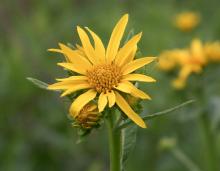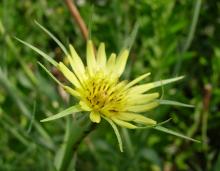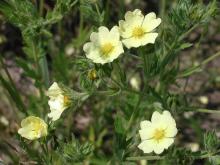Wildflowers, Grasses and Other Nonwoody Plants
Media

Species Types
Scientific Name
Amsonia illustris
Description
Often found on gravelly Ozark streamsides, shining blue star lifts its clusters of showy, light-blue flowers in late spring. A top choice for native wildflower gardening, it is interesting spring, summer, and fall.
Media

Species Types
Scientific Name
Euphorbia esula
Description
When you consider the negative effects this plant has on natural habitats, and how hard it is to control or eradicate, you almost want to rename it “leafy scourge”! This invasive plant is spreading in our state. Learn how to identify it.
Species Types
Scientific Name
Orbexilum onobrychis (formerly Psoralea onobrychis)
Description
Looking absolutely nothing like a grass, French grass, a legume, bears upright spikes of pale purple flowers on long stems from the leaf axils. The leaves are trifoliate, resembling those of soybeans.
Media

Species Types
Scientific Name
Packera obovata (formerly Senecio obovatus)
Description
Most common in the Ozarks, round-leaved groundsel is one of seven Packera species in our state. Its showy, bright yellow, daisylike flowers form flat-topped clusters that arise from sparsely leaved stems.
Media

Species Types
Scientific Name
Pyrrhopappus carolinianus
Description
One of several native plants called dandelions, Carolina false dandelion is an annual with sulphur yellow flowers and puffy seedheads.
Media

Species Types
Scientific Name
Krigia biflora
Description
There are several members of the aster family that look something like common dandelions. But unlike the familiar lawn weed, two-flowered Cynthia is a native Missouri wildflower.
Media

Species Types
Scientific Name
Heterotheca camporum (syn. Chrysopsis villosa var. camporum)
Description
Golden aster can cover entire valleys with its bright yellow flowers. It blooms June through October and is scattered mostly south of the Missouri River.
Media

Species Types
Scientific Name
Verbesina helianthoides
Description
Yellow crownbeard and its close relatives are called wingstems because of lengthwise, winged ridges along the stems. Look for it blooming, May through October, in open and rocky areas.
Media

Species Types
Scientific Name
Tragopogon dubius
Description
With its yellow composite flowers and round seedheads of fluffy “parachutes,” goat’s beard looks like a gigantic dandelion. A native of Europe, many people view it as an invasive weed.
Media

Species Types
Scientific Name
Potentilla recta
Description
Rough-fruited cinquefoil is common in most of North America in fields and pastures, along roadsides, and other disturbed areas. It’s a stout, tall, hairy plant with five yellow to cream-colored, slightly notched petals.
See Also
About Wildflowers, Grasses and Other Nonwoody Plants in Missouri
A very simple way of thinking about the green world is to divide the vascular plants into two groups: woody and nonwoody (or herbaceous). But this is an artificial division; many plant families include some species that are woody and some that are not. The diversity of nonwoody vascular plants is staggering! Think of all the ferns, grasses, sedges, lilies, peas, sunflowers, nightshades, milkweeds, mustards, mints, and mallows — weeds and wildflowers — and many more!





















